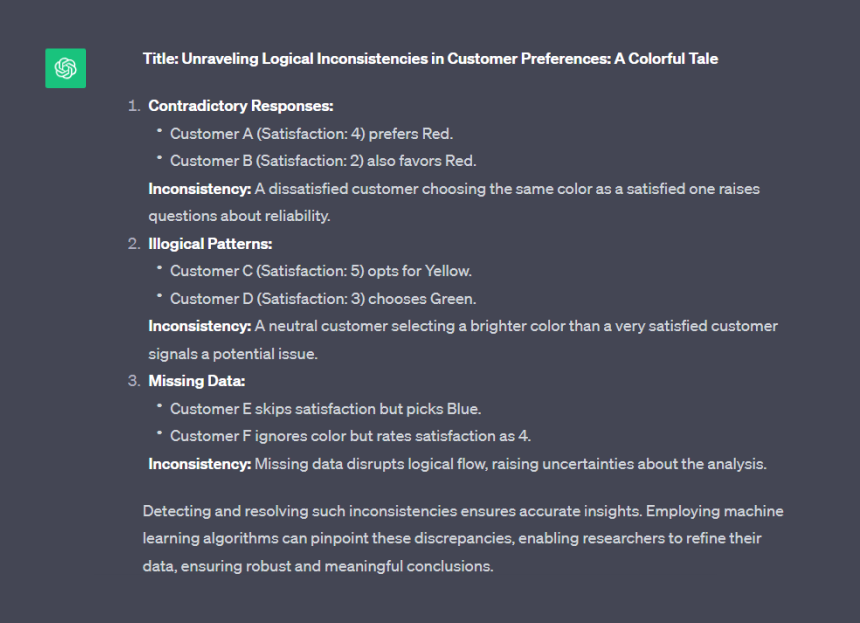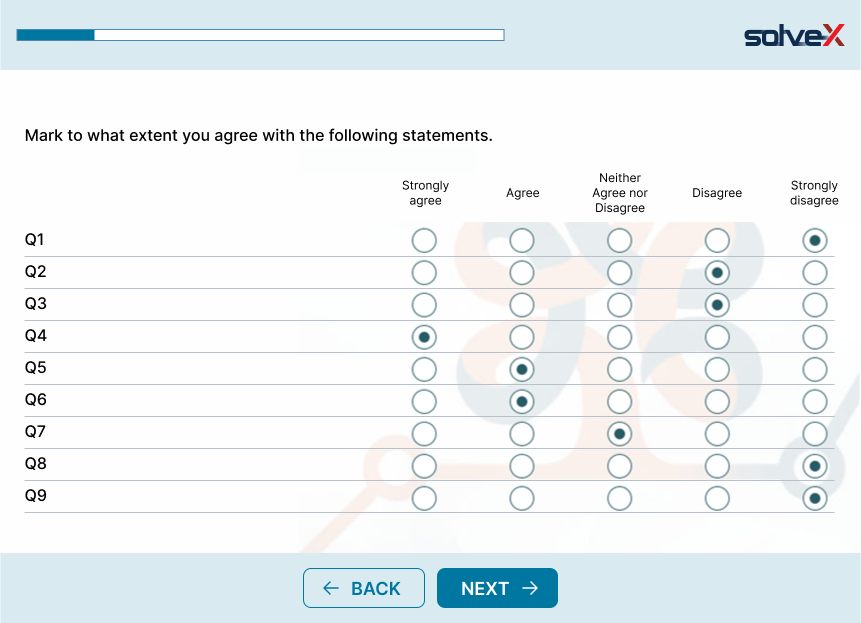Machine Learning in Marketing Research
In today’s rapidly evolving business landscape, market research has become an indispensable tool for organizations seeking to gain a competitive edge. While traditional market research methods have proven valuable, the advent of machine learning has opened up a new realm of possibilities, revolutionizing the way businesses collect, analyze, and interpret data. In this article, we will explore the intersection of machine learning and market research, delving into the innovative applications, the benefits it offers, and how it empowers businesses to make data-driven decisions with unparalleled precision and efficiency.
Detecting logical inconsistencies
Machine learning is a game-changer in market research, enabling the seamless detection of logical inconsistencies within survey data. Logical inconsistencies in the context of market research refer to inconsistencies, contradictions, or anomalies in survey data. Leveraging AI and ML models automates this process, reducing the need for manual data analysis and interpretation, saving valuable time and effort. These models possess the remarkable capability to analyze vast volumes of survey data quickly and efficiently, even handling millions of responses. Their sophisticated pattern recognition abilities unveil complex and subtle inconsistencies, non-linear relationships, and hidden patterns that might escape manual scrutiny.
ML models continuously learn and adapt, honing their skills in identifying inconsistencies where traditional methods may struggle. By using Natural Language (NL) statements, ML models can effectively process survey questions, benefiting from rule-based approaches, NLP techniques, and pre-trained models like ChatGPT. Combining neural models like LLM, specific models like NLI, as well as syntactic, lexical, and semantic models enhances the detection of various dimensions of inconsistencies. This enables market researchers to set a benchmark by computing consistency scores for concluded surveys, leading to valuable insights and empowering businesses to make well-informed decisions. The added value of ML lies in its autonomous ability to discern and flag inconsistencies promptly, ensuring a proactive approach to survey data analysis.

Logical inconsistencies example from ChatGPT
Detecting fraudulent answers
Machine learning proves invaluable in detecting fraudulent answers within survey data, going beyond merely identifying logical inconsistencies to ensure data integrity and accuracy. Traditionally, manually selecting features for fraud detection was subjective and time-consuming, but ML models excel at encompassing a wide array of features simultaneously. By leveraging ML algorithms, the model learns to distinguish deceptive responses, relieving the need for manual feature setting. Logical consistencies serve as one of the features to identify potential fraud, alongside time between answers, answer position patterns, statistics on open-ennded answers, user agent and user behavior analysis, and so on.
There are several ways to approach the model construction. In a supervised learning case, the data in the dataset is labeled as fraudulent or non-fraudulent prior to learning, while in a semi-supervised learning case, a small labeled set is used to generate additional labelled data from the larger (previously unlabelled) set. The ML model construction involves multiple steps, from exploratory analysis, data pre-processing, and splitting the dataset into training and test sets, to training the ML model, cross-validation, and evaluating the model’s performance on unseen data. With ML’s precision, accuracy, and robustness, fraudulent responses can be effectively detected, safeguarding the integrity of market research findings.

Example of fraudulent answers
Closing remarks
Machine learning will be crucial for future market research, automating the detection of logical inconsistencies in surveys and uncovering fraudulent responses. By employing artificial intelligence and machine learning models, organizations can swiftly analyze extensive data, saving time and effort. These models continuously learn and adapt, identifying complex patterns with precision and efficiency in analyses.
In an upcoming blog on this topic, we will delve into advanced profiling, synthetic data, and emotion analysis, unveiling new possibilities for machine learning in market research and enabling even more informed business decisions.

We do it with passion and dedication.
CONSENT TO PERSONAL DATA PROCESSING
I hereby acknowledge and agree with the processing of personal data, which I submit to owner and controller Solviks, programske rešitve in poslovno svetovanje, d.o.o. ((ang. Solviks, software solutions and business consulting, d.o.o) Počehova 59i, 2000 Maribor, Slovenia, e-mail: info@solve-x.net) on the Website.
I hereby acknowledge and agree that the personal data provided is processed for the following purposes:
- marketing purposes relating to offers of products and services;
- sending information about products, services and other activities.
Solviks, d.o.o. is processing name, surname, e-mail.
The legal basis for the processing of personal data is the consent of individual under Article 6(1) of General Data Protection Regulation – GDPR.
I hereby acknowledge that the personal data which I submit will be processed to the extent necessary to achieve the above-mentioned purposes.
I hereby represent that I have been informed about my right to:
- withdraw my consent to personal data processing at any time- GDPR, Article 7;
- right to be informed- GDPR; Article 13;
- obtain access to the personal data held – GDPR, Article 15;
- incorrect, inaccurate or incomplete personal data to be corrected – GDPR, Article 16;
- request that personal data be erased when it is no longer needed or if processing is unlawful – GDPR, Article 17;
- request the restriction or suppression of personal data – GDPR, Article 18;
- receive personal data in a machine-readable format (data in a data format that can be automatically read and processed by a computer) and sent it to another controller – GDPR, Article 20);
- object to the processing of personal data in specific cases – GDPR, Article 21;
- request that decisions based on automated processing concerning or significantly affecting a person and it is based on personal data are made by natural persons, not only by completers – GDPR, Article 22 (automated is only a process of inviting members to participate in surveys);
- object to the transfer of my personal data.
I hereby acknowledge that I can submit a complaint to the Information Commissioner in Slovenia (Dunajska cesta 22, 1000 Ljubljana, e-mail: gp.ip@ip-rs.si, phone: 012309730, Website: www.ip-rs.si).
I hereby acknowledge that personal data requests and any other questions about personal data can be sent to an e-mail: vesna.brlic@solve-x.net or info@solve-x.net.
I hereby represent that I have carefully read all the above provisions and do voluntarily and unequivocally agree with them.
